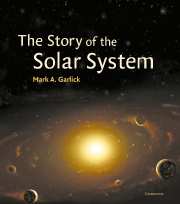Book contents
- Frontmatter
- Contents
- Miscellaneous Frontmatter
- Introduction
- Part 1 Genesis of the Sun and Solar Nebula
- Time zero: Giant Molecular Cloud
- 2 000 000 years: Solar Globule
- 2 030 000 years: Protosun
- 2 130 000 years: Solar Nebula
- 3 million years: T-Tauri Phase
- 3 million years: Outflow and Post-T-Tauri Phase
- 30–50 million years: The Main Sequence
- Part 2 Emergence of the Sun's Family
- Part 3 Solar System Past and Present
- Part 4 End of an Era
- Glossary
- Index
2 030 000 years: Protosun
from Part 1 - Genesis of the Sun and Solar Nebula
Published online by Cambridge University Press: 10 November 2009
- Frontmatter
- Contents
- Miscellaneous Frontmatter
- Introduction
- Part 1 Genesis of the Sun and Solar Nebula
- Time zero: Giant Molecular Cloud
- 2 000 000 years: Solar Globule
- 2 030 000 years: Protosun
- 2 130 000 years: Solar Nebula
- 3 million years: T-Tauri Phase
- 3 million years: Outflow and Post-T-Tauri Phase
- 30–50 million years: The Main Sequence
- Part 2 Emergence of the Sun's Family
- Part 3 Solar System Past and Present
- Part 4 End of an Era
- Glossary
- Index
Summary
Over tens of thousands of years, the gases inside the globule continued to fall away from the inside edge of the cocoon, pulled inexorably towards that dense core at the centre. By now, the core of the globule was taking on a definite shape – a gargantuan ball, about the size of the present-day Solar System out to Pluto. Its surface was still too cold to glow optically. But, at last, its central regions had warmed up significantly – to about 10 000 Celsius – and the molecules there had split into atoms of hydrogen.
This marked an important point in the development of the Sun. At this temperature, the cloud core was now hot enough for the radiation it emitted to carry a significant punch. Radiation is composed of tiny packets of energy called photons, each of which can be likened to a subatomic particle. If there are enough of these photons emitted every second they can hit like a hail of bullets, a barrage of electromagnetic force known as radiation pressure. Before this point the core of the globule had been emitting too few photons to exert a noticeable force. Now, though, as the growing waves of radiation streamed away from the warming core they slammed into the outermost regions of the globule where the gases were less dense, and slightly hindered their inbound journey. Thus the contraction of the core slowed, but it did not stop, so overwhelming was the inward pull of gravity. The very centre of the core was also dense enough now that it was beginning to become opaque to the heat radiation generated inside it.
- Type
- Chapter
- Information
- The Story of the Solar System , pp. 14 - 15Publisher: Cambridge University PressPrint publication year: 2002
- 1
- Cited by



